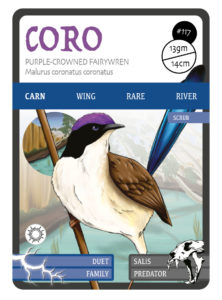CORO is the purple-crowned fairywren (Malurus coronatus)!
Species report on the purple-crowned fairywren
- Coronatus – CORO’s scientific name – literally translates to “crowned”
- An adult wren only weighs 9-13 grams
- There are two subspecies: the purple-crowned fairywren and McGilivray’s fairywren
- They live across the northern portion of Australia, from the Kimberly to the Gulf of Carpentaria
CORO is a riparian habitat specialist, meaning they live predominantly along rivers and wetland areas. Being so small, they need thick vegetation to get adequate cover from predators, preferring areas with dense low shrubs or freshwater mangroves.
They eat seeds as well as small invertebrates like beetles and ants which they find in leaf litter and debris on the ground.
They are constantly moving from bush to bush, on high alert for predators.
What is a purple-crowned fairywren?
So-named for the male’s bright purple cap, the purple-crowned fairywren is a tiny, charismatic bird occupying the northern regions of Australia. Females lack the bright purple colouration and are a cream-buff colour with chestnut-coloured cheeks. Both sexes have long, blue tails.
The average breeding age of CORO is two years, and the oldest one tracked in the wild was 12 years old. Based on similar wren species, researchers estimate purple-crowned fairywren may actually live up to 17 years old!
The wrens live in family groups consisting of a dominant breeding pair and several offspring who have stayed around as “helpers” to raise subsequent young. These helpers will help in acquiring food and feeding their newly hatched younger siblings.
When mature, female offspring tend to disperse to make their own territories further away, males usually stay closer to their natal territory. Females disperse up to a kilometre away, usually following the same river system they grew up on, some young CORO have been recorded dispersing up to 12 kilometres away!

How does the purple-crowned fairywren nest and breed?
Unlike other wren species that form social pairings but mate with many others, the purple-crowned fairywren displays a high level of fidelity within their partnership, meaning that they don’t usually mate outside their partnership. They produce two to three small round eggs up to twice a year. Breeding peaks in March to May and again in August to November, which form the transitional wet-to-dry and dry-to-wet seasons. Researchers now know that breeding coincides with the first big rain of the season so that there will be a large number of insects at the same time as baby CORO are fledging the nest – plenty of food!

CORO nests are vulnerable to SALiS (the Horsfield’s bronze cuckoo), who is a brood parasite: The cuckoo lays an egg in the wren’s nest and the wren’s instincts lead it to believe the egg is one of its own and it will raise the baby cuckoo alongside its own offspring. The baby cuckoo will soon outgrow the baby wrens and outcompete them for food.
The wren parents work extra hard to feed the baby cuckoo and compromise their own health and fitness in the process.
This is where their ANiMOZ Superpower ‘Duet’ comes into play, helping them communicate with specific songs that aid each other in watching over territories, as well as enable them to tell their chicks apart from SALiS chicks!
CORO nests are also predated upon by monitors, goannas, snakes and dragons; all common riparian predators.
What are the dangers for CORO the purple-crowned fairywren?
CORO are vulnerable to loss of habitat, mainly from introduced species. Invasive weeds clog up their habitat and outcompete the native vegetation they require to shelter in and produce the seeds they eat. Introduced large herbivores like water buffalo and cattle trample their habitat, destroying the dense understorey vegetation the wrens require to feel safe.
Black rats and feral cats also predate upon wrens and their nests. Changing fire patterns and climate change have increased the risk of large fires in the regions the wrens occupy, compromising habitat quality and reducing available shelter and food options.
Climate change has also changed flooding patterns in the region, increasing the chance of very large floods, damaging habitat that takes years to recover. Mining in the region has also reduced available habitat as it is cleared for mining expansions.
Read more species reports from ANiMOZ Ecologist, Ranger Tessa here:
Have you ever seen CORO in the wild? Make sure to share your photos and tag #wildANiMOZ!

